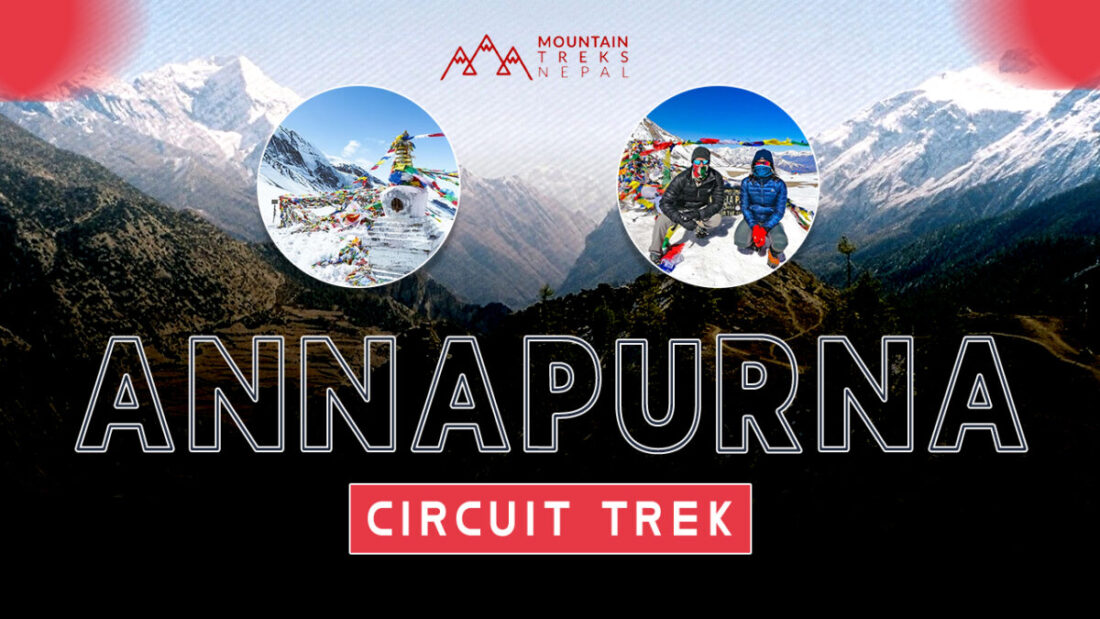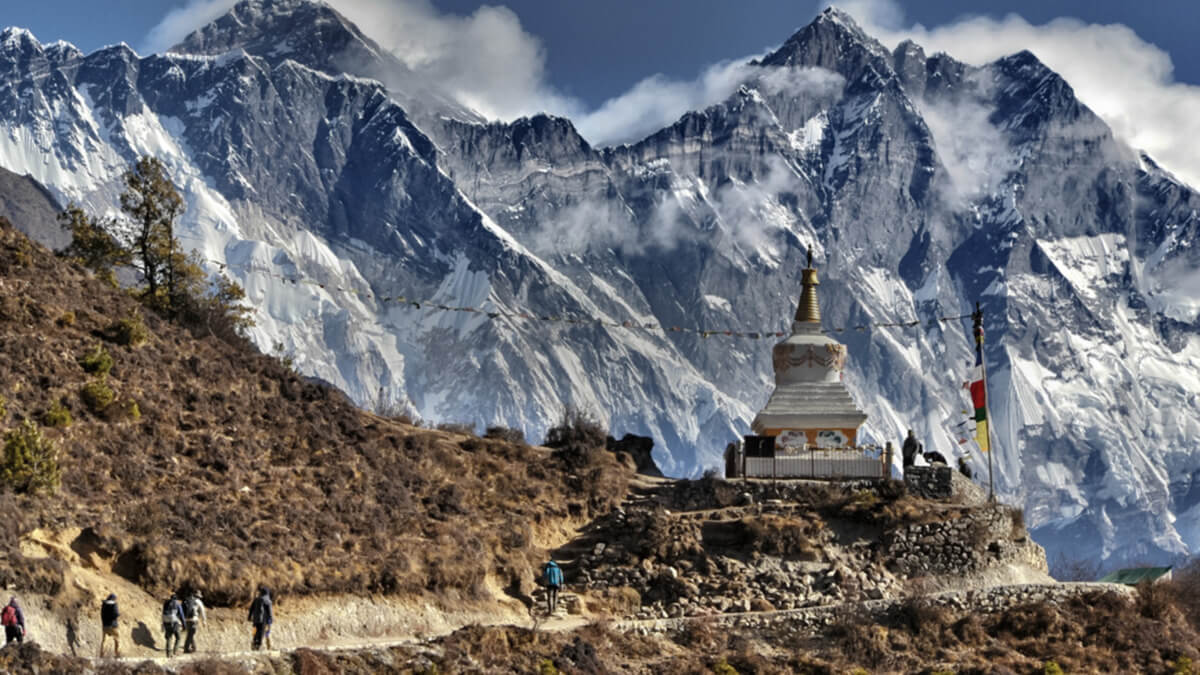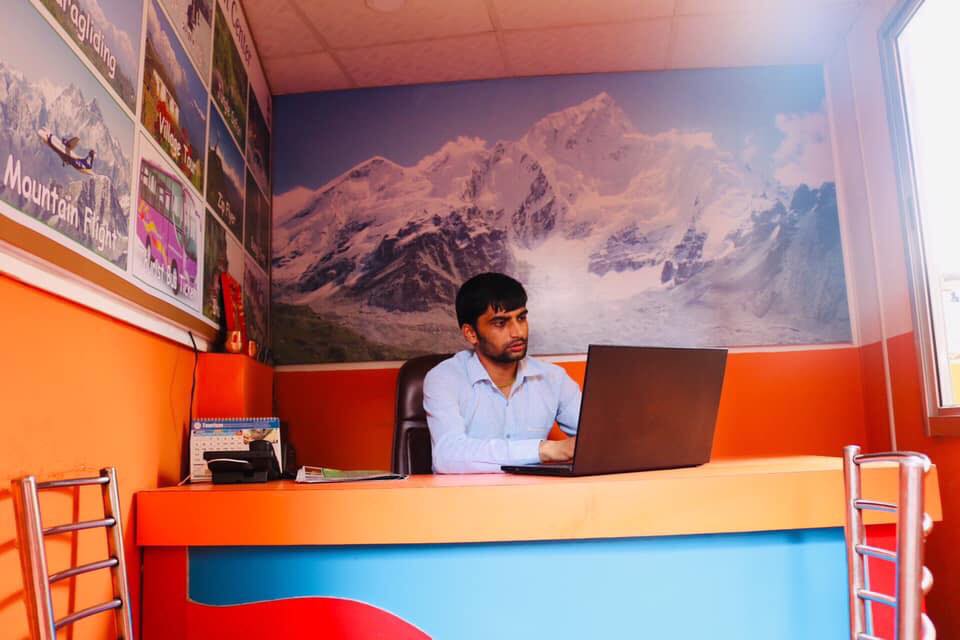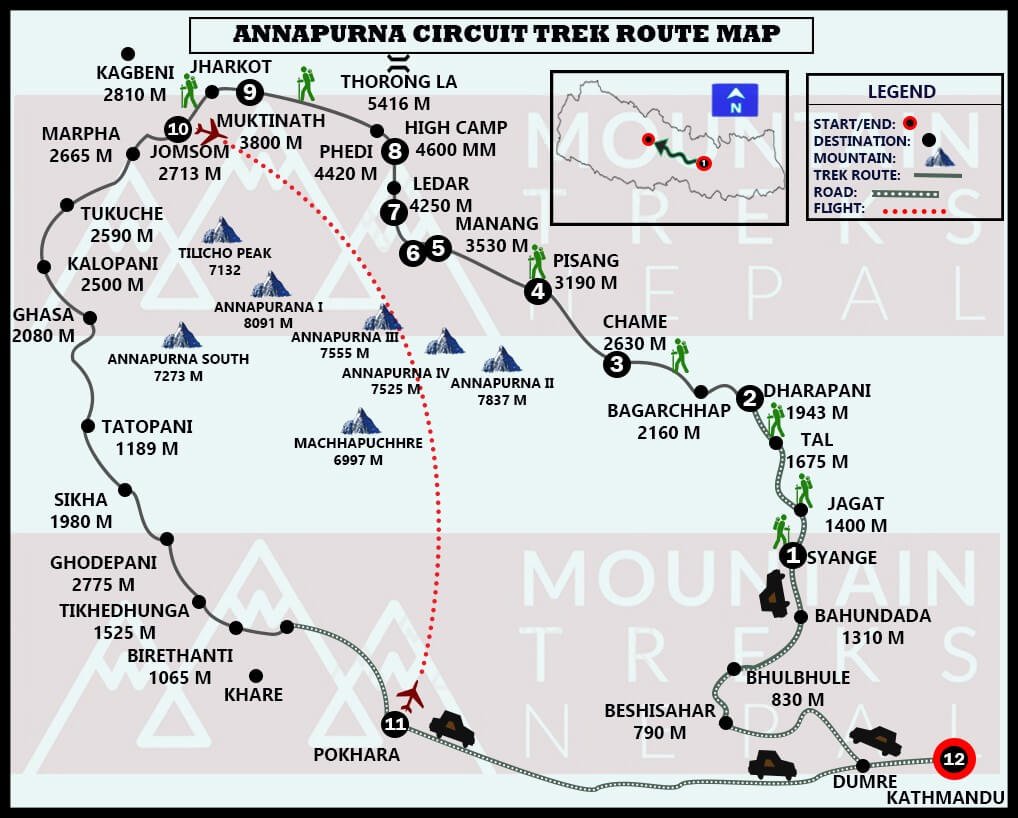Share This:

Annapurna Circuit Trek: The Ultimate Himalayan Adventure with Mountain Treks Nepal
Introduction
The Annapurna Circuit Trek is more than just a trail; it’s one of the most epic and culturally rich trekking routes in the world. Known for its breathtaking mountain scenery, diverse landscapes, and immersive cultural experiences, this trek takes you deep into the heart of Nepal’s Annapurna region. At Mountain Treks Nepal, we specialize in delivering expertly guided, safe, and unforgettable journeys through this legendary circuit.
Why Choose the Annapurna Circuit Trek?

The Annapurna Circuit Trek spans 160 to 230 kilometers depending on the route, looping around the Annapurna Massif and crossing through lush valleys, alpine forests, high passes, and dry, desert-like regions. This diversity in terrain is unmatched, making it one of the most scenic and varied trekking experiences globally.
One of the trek’s major highlights is the crossing of Thorong La Pass (5,416m), the world’s longest and highest navigable pass. This iconic section provides panoramic views of snow-covered peaks like Annapurna I-IV, Dhaulagiri, Machhapuchhre, Manaslu, Tilicho Peak, and Gangapurna.
What Makes Mountain Treks Nepal Different?

With over 500+ positive reviews on platforms like TripAdvisor, Mountain Treks Nepal is known for its reliable service, experienced guides, and deep knowledge of the Annapurna region. From permits to porters, we handle every detail so you can focus on the journey.
- Local expertise: Our guides are from the region and provide cultural insights and safety guidance.
- Customized itineraries: Whether you want to include Tilicho Lake or extend to Upper Mustang, we personalize your route.
- Responsible tourism: We promote ethical travel that supports local communities
.
Trekking Itinerary Overview
Detailed Itinerary
1. Arrival in Kathmandu
You will land in Kathmandu, the capital city of Nepal, and this would be where your journey really begins. On arrival, our representative will leave no space for your cordial welcome and then transfer to your hotel. Later in the evening, you will spend wandering around Thamel, the buzzing tourist hub with its variety of restaurants and shops and cultural charm.
Kathmandu is featured with amazing places such as the Swayambhunath Stupa (Monkey Temple) and Kathmandu Durbar Square. The city, which boasts both cultural and natural beauty, will be the first place to overnight today.
2. Drive to Syange via Besisahar
On the second day of the Annapurna Circuit Trek 14 Days, you will leave the crowds of Kathmandu and set on a journey to beautiful Besisahar. The journey cuts across the beautiful countryside featuring terraced farms, busy villages, and the Marsyangdi River. Besisahar, the headquarters town for the Lamjung district, is the point of beginning for many trekkers preparing to embark on the Annapurna Circuit. From here, a private vehicle takes you to Syange, your base for the night.
Located at the banks of the Marsyangdi River, Syange marks the beginning of your trek through rough trails and shady green landscapes. You will spend the night at a lodge, preparing for the trek.
3. Trek to Dharapani (1,881m)
Today begins early in the morning with a warm breakfast. After that, you will head towards Dharapani from Syange, which takes around 6 hours. The trek goes along rugged-style paths with suspension bridges to cross the Marsyangdi River. You are rewarded with spectacular views of the hills and valleys along the trail. You will come across the beautiful village of Tal, where we will have a big lunch. The trail climbs into pine forests and terraced fields that complete the slide into transitional shifts and beautiful scenery.
Signs of Buddhist prayer flags and chortens become more prominent near Dharapani, indicating your cultural move toward Tibetan-influenced lands. The village serves as a base for tonight’s stay.
4. Trek to Chame (2,725m)
The trek to Chame becomes more difficult but worth its effort because from Dharapani onwards. The trek through thick forests and also many streams before reaching Chame. The first major place is Bagarchap, a typical village where glimpses into hill culture can be appreciated. Further, the trail passes through Danakyu village, offering you the views of the Annapurna and Dhaulagiri peaks.
The hike continues to the Tamang village, where you can find a perfect lunch spot with a panoramic view of the Manaslu range. The last stretch brings you to Chame, the Headquarters District of Manang. There are natural hot springs to dip your tiredness away while basking in the glorious view of Annapurna II.
5. Trek to Pisang (3,100m)
Chame to Pisang is a fascinating trek, where landscapes change offering you the diverse view of the Annapurna Circuit Trail. You will start with the crossing of the Marsyangdi River by a suspension bridge. The trail then cuts through dense pine forests and past apple orchards in the village of Bhratang. The climbing terrain becomes rather dramatic with the mighty peaks of the Annapurna above and with rocky cliffs dominating the horizon.
After crossing a series of suspension bridges, the trail opens into the expansive Pisang Valley. Pisang serves with the incredible views of the mountains, such as Annapurna II and Pisang Peak. You will stay overnight at Pisang at a tea house.
6. Trek to Manang (3,540m)
Climbing steadily up through the ridge, the trail leads you into today’s grand destination, Manang Valley. Deepening into the valley brings you into Hongde village. These settlements feature prayer flags and wheels that influence Tibetan culture.
Braga, the final phase of this trail, is a village with a historic monastery on top of a hill, and then, at the end of the trail, Manang will be reached. This village features several tea houses, where you can stay overnight and have the best views of the Annapurna range.
7. Acclimatization day at Manang
Acclimatization Day is essential once you are above 3500 meters, and hence this day will be spent discovering Manang and its nearby destinations as your body adjusts to this elevation. A short hike to nearby sites, like the Gangapurna Glacier or just a walk up to a viewpoint that gives an alluring glance of Gangapurna Lake shining waters, could be enjoyed.
Manang is also a cultural hub, providing some insight into the way of life and customs of the Gurung and Tibetan people. You will witness the serenity and get to interact with the locals. You stay overnight at a tea house, getting ready for the Thorong La Pass ascent.
8. Trek to Yak Kharka (4,090m)
From Manang, the trail leads to Yak Kharka and marks your entry into the high wilderness of the heavens. The trail carries on at a gradual pace and opens out to extensive views of barren landscapes and snow-covered mountain tops. From the small settlements, yaks graze as the locals carry on their daily routines, completely blended with the rugged surroundings.
The air begins to thin and the vegetation starts to dwindle as one approaches Yak Kharka, truly signifying the remoteness and beauty of this area. You will spend the night at a local tea house.
9. Trek to Throung Phedi (4,420m)
On the ninth day of the Annapurna Circuit Trek, the adventure from Yak Kharka to Thorong Phedi leads us closer to the lap of Thorong La Pass – Thorong Phedi. The ascent is gradual and marked by a few switchbacks and rocky patches and is laced with alpine meadows and far-off peaks. The place speaks volumes with its rugged beauty, where yaks and other livestock find limited pastures, thus ensuring a rural touch to the landscape.
Now, at Thorong Phedi, its snow-covered peaks are visible through its clear surroundings. Night at this altitude is more challenging due to freezing temperatures, so you must be prepared with your gear and equipment.
10. Thorong La Pass (5,416m) to Muktinath (3,800m)
Today is the trip highlight of the Annapurna circuit, as you will reach the highest point of this trek – Thorong La Pass. You will wake up early to face the cold, crisp mountain dawn in order to move toward the pass. The well-defined trail leads to prayer flags and cairns that mark the summit-Thorong La, at 5,416 meters. As you reach the top of the pass, you will get rewarded with panoramic views of the Annapurna and Dhaulagiri ranges, which stretch as far as the eye can see.
From the pass, one can descend to Muktinath following the rugged trail. Muktinath is a sacred place for both Hindus and Buddhists. It is at this point that the Muktinath Temple, with its sacred 108 water spouts and a burning eternal flame, symbolizes the spiritual close of an expedition into the heights. This will be a lasting memory in its beautiful surroundings and that heavenly significance.
11. Trek to Jomsom (2,670m) via Kagbeni
On the eleventh day of the Annapurna Circuit Trek, the trip will entail a journey toward Jomsom from Muktinath as a mostly downhill trek into incredible open landscapes. The surroundings are dominated by soaring views down to the Kali Gandaki River. As you descend, you will pass across the rural village of Kagbeni. Its Tibetan-influenced narrow alleys are lined with whitewashed houses against seemingly endless backdrops of the Nilgiri peaks. In this traditional village, Kagbeni, the old monastery brings an additional mystical touch to it all.
From Kagbeni onwards, the trail hugs the bank of the river, passing through beautiful scenery before arriving in Jomsom. Jomsom is a bigger town by the standards of most villages along the circuit and provides a good resting place to get back on the trail. Overnight stay at lodge in Jomsom.
12. Fly to Pokhara
After long days of rugged trekking, you will board a scenic flight from Jomsom to Pokhara. The flight is an experience in itself because it showcases amazing aerial views of the Himalayas and deep valleys. As you reach Pokhara, you will transfer to your hotel, where you can rest and relax or explore the beautiful lakeside town of Pokhara.
Pokhara is a beautiful and natural place where a boat ride on Phewa Lake, Devi’s Fall and Gupteshwar Cave are some of the major attractions. Or maybe you want to explore through the colorful streets of Lakeside, which are filled with cafes, shops, and art galleries. Overnight stay at a hotel in Pokhara.
13. Drive to Kathmandu By Tourist Bus
Today, you will wake up early in the morning, have a warm breakfast, and show up at a bus station for a 6 to 7 hours ride to Kathmandu.
The journey takes you through Tanahun and Dhading Districts, offering you to enjoy the natural sceneries of green terraced fields, lush forests, and ever-flowing Marsyangdi and Trishuli River.
As you reach Kathmandu, you will be escorted to your respective hotel where you can rest. Or you can go on an exploration journey in Thamel and celebrate your completion of the Annapurna Circuit Trek.
14. Final Departure
On your final day in Nepal, you’ll be transferred to Tribhuvan International Airport for your flight home. You will bid farewell to Nepal and Mountain Treks Nepal Team and then finalize your legal formalities before boarding on a plane. Although this journey is complete, you will have ever-lasting memories of the Annapurna Circuit Trek throughout your life.
Trip Includes
- Airport pick up and drop by private car / van (depends on group size)
- Domestic air ticket from Jomsom to Pokhara including airport taxes.
- 14 days Trip, 11 of which include 3 meals a day (Breakfast, lunch and dinner)
- Two night’s hotel in Kathmandu on the basis of bed and breakfast.
- Experienced English speaking trekking guide and porters (one porter for two person) salary / accommodation / insurance.
- Kathmandu – Beshishar drive by local bus and Pokhara – Kathmandu drive by tourist bus.
- All the necessary trekking entry permit. (Trekking permit / TIM’s card etc.)
- One night hotel in Pokhara city on the basis of bed and breakfast.
- First Aid Medical Kit Box
- All the government taxes and service charge
- Sleeping bag, down jackets and duffel bag – if Necessary (Need to returned after the trek)
- Farewell dinner
Trip Excludes
- Personal Travel Insurance .
- Nepal entry visa.
- International airfare
- Drinks (mineral water, Tea, coffee, whisky) or other snacks and any meals beside breakfast, lunch and dinner. Hot shower, charge etc.
- Tips for Guide and potter.
- Snacks and other personal expenses.
- Personal trekking equipment.
- Any others expenses which are not mentioned on the “Trip Includes” Section.
Route Map

Cultural and Natural Highlights
The Annapurna Circuit is not just about mountains. You will:
- Visit Manang and Muktinath, two culturally rich villages with Buddhist and Hindu significance.
- Trek through Ghyaru and Upper Pisang, known for ancient architecture and prayer walls.
- Walk along the world’s deepest gorge, Kali Gandaki River, nestled between Dhaulagiri and Annapurna.
- Experience dramatic landscape changes, from rhododendron forests to arid high-altitude deserts.
Thorong La Pass: The Crown Jewel Crossing Thorong La Pass is a rite of passage for trekkers. The high altitude, unpredictable weather, and thin air make it physically demanding but incredibly rewarding. The views from the top stretch across the Himalayas and are truly unforgettable.
Add-On: Tilicho Lake Extension Many trekkers choose to add a detour to Tilicho Lake (4,949m), the world’s highest glacial lake. It adds a few days to the trek but rewards you with jaw-dropping alpine scenery.
Logistics and Support
Mountain Treks Nepal provides:
- TIMS card and ACAP permit
- Airport transfers and hotel stays in Kathmandu and Pokhara
- Local transportation and Jeep access to trailheads
- Accommodation in cozy tea houses
- Three meals per day during the trek
- Experienced English-speaking guides and helpful porters
Best Time to Trek
- Autumn (Sep-Nov): Clear skies, best mountain views, and comfortable temperatures.
- Spring (March-May): Blooming rhododendrons and pleasant trekking weather.
Who Is This Trek For?
The Annapurna Circuit Trek is moderately challenging and suitable for trekkers with a good fitness level. It’s ideal for those looking to experience a full Himalayan journey with high passes, diverse terrain, and real cultural immersion.
FAQs
- Is Annapurna Circuit Trek same as Annapurna Round Trek?
Yes. Both names refer to the same route circling the Annapurna Massif. Some also call it the Thorong La Pass Trek. At Mountain Treks Nepal, we offer flexible itineraries under any of these names. - Can I add Tilicho Lake Trek Itinerary?
Absolutely. We can customize your Annapurna Circuit Trek to include Tilicho Lake, one of the highest lakes in the world, adding just 2-3 extra days. - Do I need Travel Insurance?
Yes. Travel insurance with high-altitude coverage and emergency evacuation is mandatory when booking with Mountain Treks Nepal. - Thorong Phedi or Thorong High Camp which is safer?
We recommend staying at Thorong Phedi for better sleep and acclimatization before the pass. High Camp is riskier due to altitude. - Which is the best season to do Annapurna Circuit Trek?
The best times are September to November and March to May for clear skies, safe trails, and stunning mountain views. - How much weight can my porter carry?
Porters from Mountain Treks Nepal carry a maximum of 20-25 kg total (shared between two clients), ensuring their safety and ethical treatment. - What permits are required?
You need an ACAP permit (Annapurna Conservation Area Project) and a TIMS card, which we arrange for you. - Where can I reach by jeep on Annapurna Circuit Trek?
Depending on the season, you can travel by jeep up to Chame or even closer to Manang. We manage all local transport logistics. - What is the altitude of Thorong La Pass?
Thorong La Pass sits at 5,416 meters (17,769 feet) and is the highest point on the trek. - Can I extend my trek to the Upper Mustang Region?
Yes. We offer custom extensions into Upper Mustang after the Annapurna Circuit, including special permits and logistics. - How long does it take to cross Thorong La Pass?
Crossing usually takes 7–8 hours from Thorong Phedi, with early starts recommended to avoid winds. - What mountains are visible during the trek?
You’ll see Annapurna I-IV, Dhaulagiri, Machhapuchhre, Tilicho Peak, Gangapurna, Pisang Peak, and more. - Why do people confuse Annapurna Base Camp and Annapurna Circuit?
Both are in the Annapurna region but are entirely different treks. The Circuit is longer, higher, and loops around the range, while ABC is a shorter in-and-out trek to the base of Annapurna I. - Is Annapurna Circuit Trek Nepal’s classical trekking route?
Yes. It’s one of Nepal’s most historic and iconic treks, offering a true Himalayan experience. - What are the food and accommodation conditions like?
Tea houses provide hearty meals (dal bhat, noodles, soups) and simple but comfortable rooms. Mountain Treks Nepal ensures the best available lodges. - What is the distance of Annapurna Circuit Trek?
The full trek is between 160 km and 230 km, depending on start and end points. - Can I do solo trekking on the Annapurna Circuit?
While solo trekking is allowed, we recommend going with a guide for safety, navigation, and cultural connection. With Mountain Treks Nepal, you get experienced guidance and peace of mind.
Conclusion
The Annapurna Circuit Trek remains one of the greatest trekking adventures on earth. With its dramatic landscapes, rich cultural interactions, and high-altitude thrills, it offers a complete Himalayan experience. When you choose Mountain Treks Nepal, you’re choosing a team that prioritizes safety, quality, and meaningful travel.
Book your trek today and leave your footprints on Nepal’s most legendary trail.
